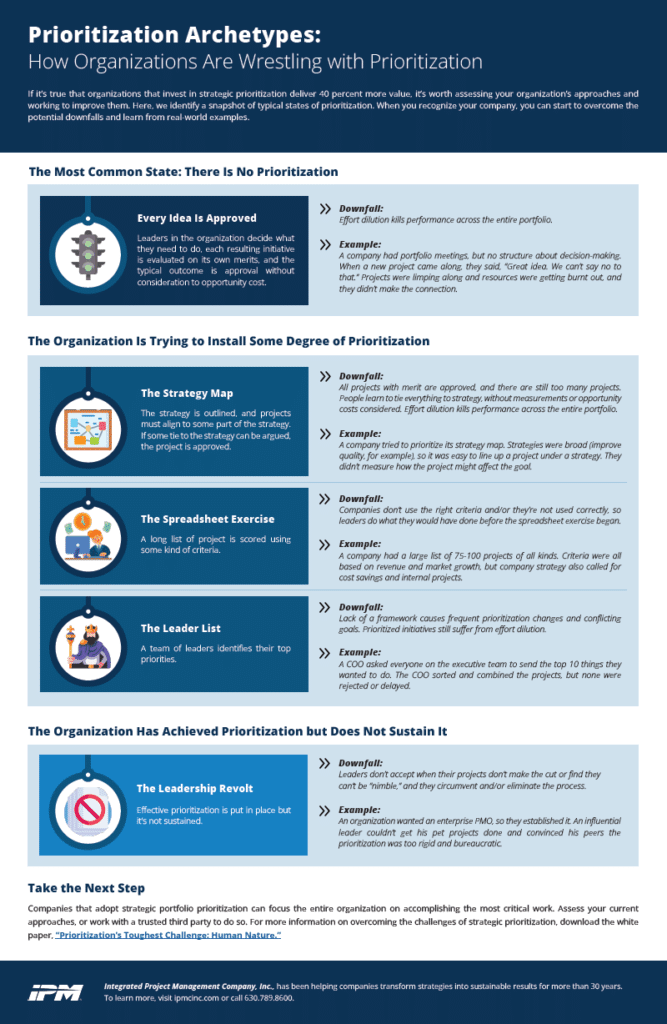Strategic prioritization is challenging but necessary. You have to compare apples to oranges without complete data. You—and all your colleagues—have to set aside personal motivations and pet projects for the benefit of the organization. And, as we learned in the white paper, “Prioritization’s Toughest Challenge: Human Nature,” we have inherent biases working against us.
If it’s true that organizations that invest in strategic prioritization deliver 40 percent more value, it’s worth assessing your organization’s approaches and working to improve them. Here, we identify a snapshot of typical states of prioritization. When you recognize your company, you can start to overcome the potential downfalls and learn from real-world examples.
Download a pdf of the infographic →
The Most Common State: There Is No Prioritization
Archetype: Every Idea Is Approved
Leaders in the organization decide what they need to do, and then evaluate each resulting initiative on its own merits. The typical outcome is approval without consideration to opportunity cost.
Downfall: Effort dilution kills performance across the entire portfolio.
Real-world example: The company had portfolio meetings, but no structure about decision-making. When a new project came along, they said, “Great idea. We can’t say no to that.” Projects were limping along and resources were getting burnt out, and they didn’t make the connection.
The Organization Is Trying to Install Some Degree of Prioritization
Archetype: The Strategy Map
The strategy is outlined, and projects must align to some part of the strategy. If some tie to the strategy can be argued, the project is approved.
Downfall: The company approves all projects with merit, and there are still too many projects. People learn to tie everything to strategy, without measurements or opportunity costs considered. Effort dilution kills performance across the entire portfolio.
Real-world example: A company tried to prioritize its strategy map. Strategies were broad (improve quality, for example), so it was easy to line up a project under a strategy. They didn’t measure how the project might affect the goal.
Archetype: The Spreadsheet Exercise
A long list of projects is scored using some kind of criteria.
Downfall: Companies don’t use the right criteria and/or they’re not used correctly, so leaders do what they would have done before the spreadsheet exercise began.
Real-world example: A company had a large list of 75-100 projects of all kinds. They based all criteria on revenue and market growth, but company strategy also called for cost savings and internal projects.
Archetype: The Leader List
A team of leaders identifies their top priorities.
Downfall: Lack of a framework causes frequent prioritization changes and conflicting goals. Prioritized initiatives still suffer from effort dilution.
Real-world example: The COO asked everyone on the executive team to send the top 10 things they wanted to do. The COO sorted and combined the projects, but they didn’t reject or delay any of them.
The Organization Has Achieved Prioritization but Does Not Sustain It
Archetype: The Leadership Revolt
Effective prioritization is put in place but it’s not sustained.
Downfall: Leaders don’t accept when their projects don’t make the cut or find they can’t be “nimble,” and they circumvent and/or eliminate the process.
Real-world example: The organization wanted an enterprise PMO, so they established it. An influential leader couldn’t get his pet projects done and convinced his peers the prioritization was too rigid and bureaucratic.
Take the Next Step
Companies that adopt strategic portfolio prioritization can focus the entire organization on accomplishing the most critical work. Assess your current approaches, or work with a trusted third party to do so. For more information on overcoming the challenges of strategic prioritization, download the white paper, “Prioritization’s Toughest Challenge: Human Nature.”
Download a pdf of the infographic →
"*" indicates required fields
